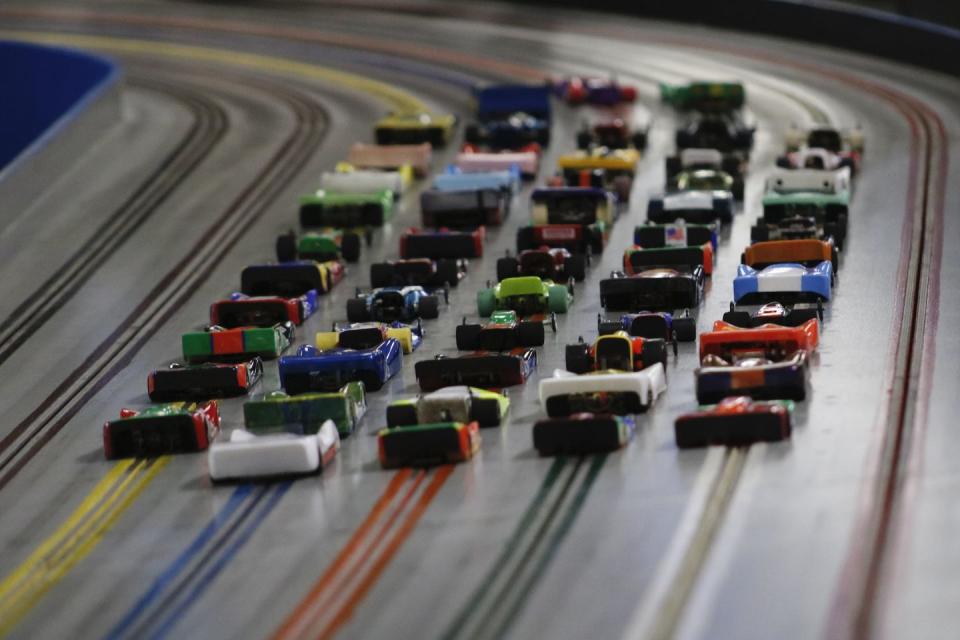How Legendary Car Designer Larry Shinoda Changed the World of Slot Car Racing

Concept designs often don't make good production vehicles. The more exciting ones tend to ignore regulations and convenience, favoring low-slung, flowing body lines that would be hell to mass-produce. But legendary car designer Larry Shinoda found a new home for some cast-off concept designs of the Sixties: Slot car racing. His hobby became a huge, semi-secret success.
Like many Detroit car industry designers and engineers in the Sixties, Shinoda was an obsessive slot car racer. On nights and weekends, you could find all kinds of Big Three employees flocking to slot car tracks, putting their professional skills to use building and modifying their cars, chasing speed and victory at grooved circuits throughout Michigan and beyond.
It turns out, concept designs penned without concern for the realities of road-going vehicles made for excellent slot car bodies. Shinoda, best known for designing the 1963 Corvette Sting Ray and the 1969 Mustang Boss 302 among dozens of influential concept and production cars, found a new home for plenty of those designs in his off-hours racing hobby.
GM played a role in Shinoda's scale racing antics, even if the company didn't know about it at the time. Shinoda secretly used the automaker's vacuum-forming machines, intended for making one-off prototype parts, to create slippery, aerodynamic slot car bodies based on his concept-car designs.
“He basically used GM corporate funds illegally to make the slot car bodies as an after-hours project," Eliot Erlandson told Road & Track. Erlandson, a designer working in the car industry, is a huge slot car enthusiast with deep knowledge of the history of the hobby, who calls Shinoda his personal hero.

Since they were far sleeker than the realistic, production car-shaped slot cars being sold at the time, Shinoda's custom jobs were spectacular racers. Some Detroit-area tracks started buying and reselling Shinoda's bodies, while others began vacuum-forming their own creations inspired by his work. These weren't mail-order bodies available to anybody; you had to know a guy who knew Shinoda.
"If you worked at the GM design centers you could buy directly from Larry, or at about 10 tracks in the Detroit area," Erlandson said. If you didn't have a Detroit-area hookup, though, you were stuck with what the mass market had to offer.
But the idea behind Shinoda's successful cars quickly spread. His wild shapes founded a whole new class of slot cars called "Thingies," slick, low-slung designs that abandoned production-car proportions in favor of pure experimentalism. Thingies dominated slot car racing until the advent of "wing cars," which played with downforce and extremely low centers of gravity for even greater performance.
Sleek bodies weren't the only thing Detroit brought to the slot car scene. While Shinoda was changing the shape of slot cars, Big Three engineers were pumping up their powerplants. Ted Lech, another GM employee, founded Dyna-Rewind motors in his basement. By expertly tuning and refining mass-produced motors for more power, Lech became famous for building some of the fastest slot cars of the Sixties.
Powered by Dyna-Rewind motors and draped in slippery Shinoda-inspired bodywork, the slot cars of the Detroit scene were some of the fastest in the world. And they got even faster with an ingenious engineering trick: the Detroit Slider, an adjustable wheelbase that compressed under deceleration to give a short wheelbase in corners, then expanded on acceleration for straight-line stability. Dyna-Rewind and others sold kits to convert mass-produced slot cars into Detroit Sliders, kicking off a whole new era of faster and more capable racers. That was a dream come true for Shinoda and the other slot car fanatics working in the car industry.
“Really, Shinoda wanted his designs out there," Erlandson said. "And the GM guys wanted to be known as the best.”

Now, a Michigan event celebrates Shinoda's era-defining contribution to slot-car racing. The Shinoda Reunion, organized by Erlandson and now in its fourth year, gathers collectors and fans of Thingy-era slot cars, with a focus on the legendary designer's semi-illicit, competition-destroying creations.
The Shinoda Reunion features two classes of slot car racing: "Period Class," a celebration of Sixties slot cars requiring period-correct parts and designs, and "Unlimited," for classic Shinoda designs underpinned by modern slot-car technology. The Shinoda Reunion takes place on November 30, 2019 at Downriver Speedway in Lincoln Park, Michigan. Doors open at 11:00 a.m. and racing begins at 3:00 p.m. You can find more details on the event's Facebook page.
And if you're interested in learning more, Casey Putsch from Genius Garage has an in-depth video interview with Erlandson about The Shinoda Reunion, and a solo video about his Shinoda-body slot cars and other "thingies."

You Might Also Like

